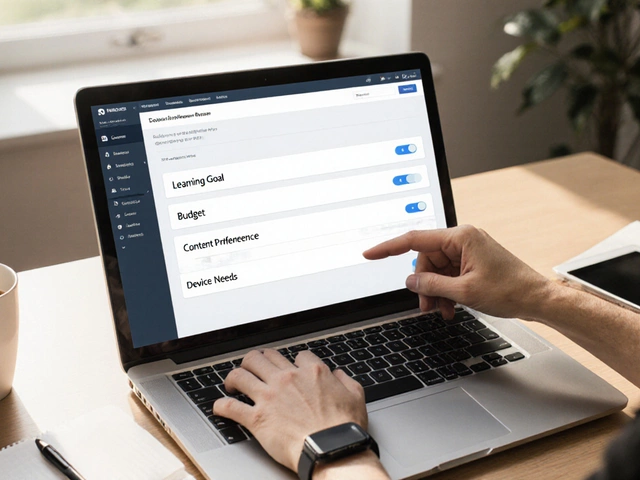
Spoken English Fluency Tracker
Daily Fluency Log
Progress Report
Weekly Trend
Key Insights
When you hear the phrase English speaking the ability to communicate ideas, emotions, and details fluently in everyday conversation, you probably picture a native‑like accent or perfect grammar. But real fluency starts in the brain, not the mouth. Brain training a set of mental exercises that boost the neural pathways involved in language production and comprehension can shortcut the months‑long grind of rote memorisation. Below you’ll discover practical, science‑backed steps that let you improve spoken English without endless classroom drills.
Quick Takeaways
- Leverage neuroplasticity by practising in short, intense bursts.
- Combine shadowing, tongue twisters, and spaced repetition for balanced skill growth.
- Create feedback loops with recordings, peers, or AI tools.
- Immerse yourself daily - even 15 minutes of a podcast counts.
- Track progress with a simple fluency checklist.
Why Brain Training Works for Language
Neuroplasticity - the brain’s ability to rewire itself - peaks when you’re challenged just beyond your comfort zone. Studies from the University of Helsinki (2023) show that learners who practice a new language for 20‑minute high‑intensity sessions three times a week develop stronger auditory‑motor connections than those who study for two hours passively.
In plain terms: the brain loves focused, varied practice. That’s why mixing listening, speaking, and mental rehearsal beats marathon reading sessions.
Step‑by‑Step Brain‑Boosting Routine
- Warm‑up with active listening (5 min): Play a short news clip or podcast segment. Write down every word you recognise, then repeat the sentence out loud. This kicks the auditory cortex into gear.
- Shadowing technique (7 min): Choose a native speaker audio, pause after each sentence and immediately repeat it word‑for‑word, mimicking rhythm and intonation. Do this without looking at a transcript first - the goal is mimicry, not translation.
- Tongue‑twister sprint (3 min): Pick a phrase like “She sells seashells by the seashore” and say it three times faster each round. This trains mouth muscles and improves fluency under pressure.
- Vocabulary chunking (5 min): Instead of learning isolated words, bundle them into collocations (e.g., “make a decision”, “take a break”). Write a short spoken sentence using each chunk.
- Spaced repetition review (5 min): Use an app like Anki to review the chunks you practiced yesterday. The spacing effect cements long‑term retention.
- Feedback loop (5 min): Record yourself saying a 30‑second monologue. Play it back, note pronunciation slips, and re‑record. Over time you’ll hear measurable improvement.
The whole routine totals about 30 minutes - perfect for a commute or a coffee break.
Key Techniques Compared
| Technique | How it works | Best time to use | Primary benefit |
|---|---|---|---|
| Shadowing | Listen and instantly mimic the speaker’s exact words, tone, and speed. | During early listening practice when you need natural rhythm. | Improves intonation and real‑time processing. |
| Repetition | Read a sentence, pause, then say it aloud multiple times. | When you need to solidify tricky grammar or new vocabulary. | Builds muscle memory and confidence. |

Creating Your Own Immersion Pocket
Immersion doesn’t require a move abroad. Build a daily “English bubble” with these simple hacks:
- Change phone and app language settings to English.
- Subscribe to a short‑daily newsletter (e.g., "5‑minute English").
- Join a local conversation club or an online speaking buddy platform.
- Use subtitles on your favourite shows, then replay the scene without them.
Each habit adds up. Even 15 minutes of background listening while cooking counts as passive immersion, which research shows reinforces the auditory pathways you train during active practice.
Tracking Progress Without Stress
Many learners quit because they can’t see growth. Use a simple fluency checklist:
- Number of new collocations used in a conversation.
- Time taken to shadow a 1‑minute audio (shorter = faster processing).
- Pronunciation rating from a peer or AI (scale 1‑5).
- Confidence level on a 1‑10 self‑scale after each speaking session.
Review the checklist weekly. When three out of four metrics improve, you know the brain training is paying off.
Common Pitfalls and How to Dodge Them
- Over‑loading vocabulary. Focus on 5‑7 new chunks per week; quality trumps quantity.
- Skipping the feedback loop. Recording is cheap, but ignoring it stalls progress.
- Only studying grammar. Language is a skill, not a subject. Prioritise speaking from day one.
- Being inconsistent. Neuroplastic changes fade if you miss two consecutive days.
Putting It All Together - A Sample 7‑Day Plan
| Day | Focus | Activities (≈30 min) |
|---|---|---|
| Monday | Listening + Shadowing | News clip → shadow → feedback recording |
| Tuesday | Pronunciation | Tongue twisters → repeat tricky words → record |
| Wednesday | Vocabulary Chunking | Learn 5 collocations → use in short monologue |
| Thursday | Spaced Repetition | Review Monday & Tuesday chunks via flashcards |
| Friday | Immersion | Watch a 10‑minute sitcom with subtitles, then retell the plot |
| Saturday | Conversation Club | Join a 30‑minute Zoom group, focus on using new chunks |
| Sunday | Reflection | Rate confidence, note improvements, set next week’s goals |
Final Thought
Training your brain for English speaking isn’t a magic pill; it’s a set of habits that shape neural pathways. Stick to short, varied sessions, create real‑time feedback loops, and surround yourself with English every day. In a few weeks you’ll notice the words flowing more naturally, and that feeling of hesitation will start to fade.
Frequently Asked Questions
How long does it take to see real improvement?
Most learners notice smoother speech after 3‑4 weeks of daily 20‑minute brain‑training sessions, provided they keep the feedback loop active.
Do I need expensive software?
No. Free podcasts, YouTube videos, and basic voice‑recording apps are enough. A spaced‑repetition app like Anki (free) adds a scientific edge.
Can I practice alone, or do I need a partner?
Both work. Solo practice hones accuracy; a partner adds spontaneity and real‑world correction. Aim for a mix.
What’s the best time of day for brain training?
When your mind is alert but not exhausted - typically mid‑morning or early evening. Consistency matters more than exact hour.
How do I know if I’m using the right technique?
Track the metrics in the fluency checklist. If your shadowing speed improves and confidence scores rise, you’re on the right track. Adjust if any metric stalls for two weeks.







